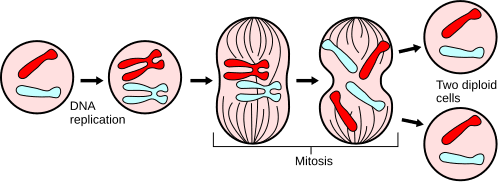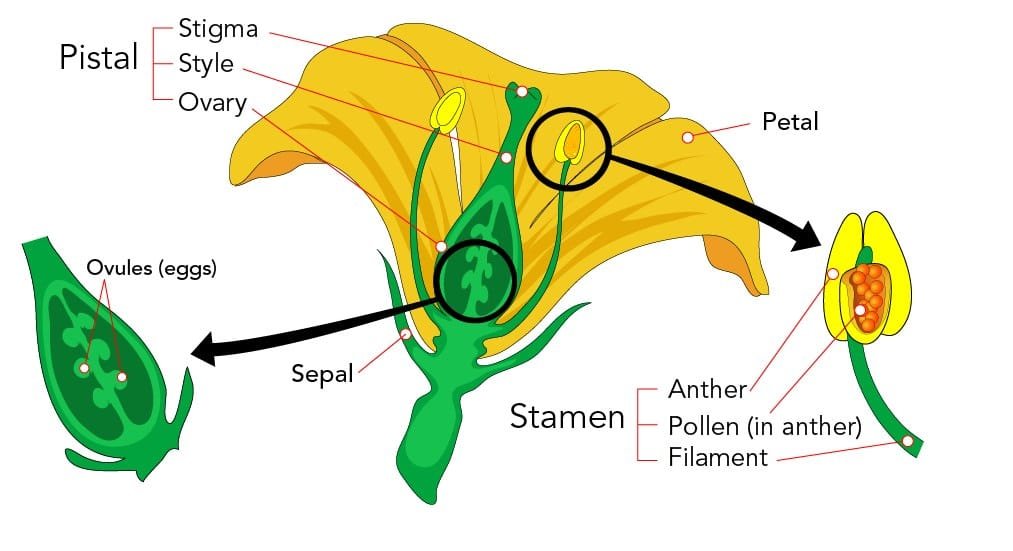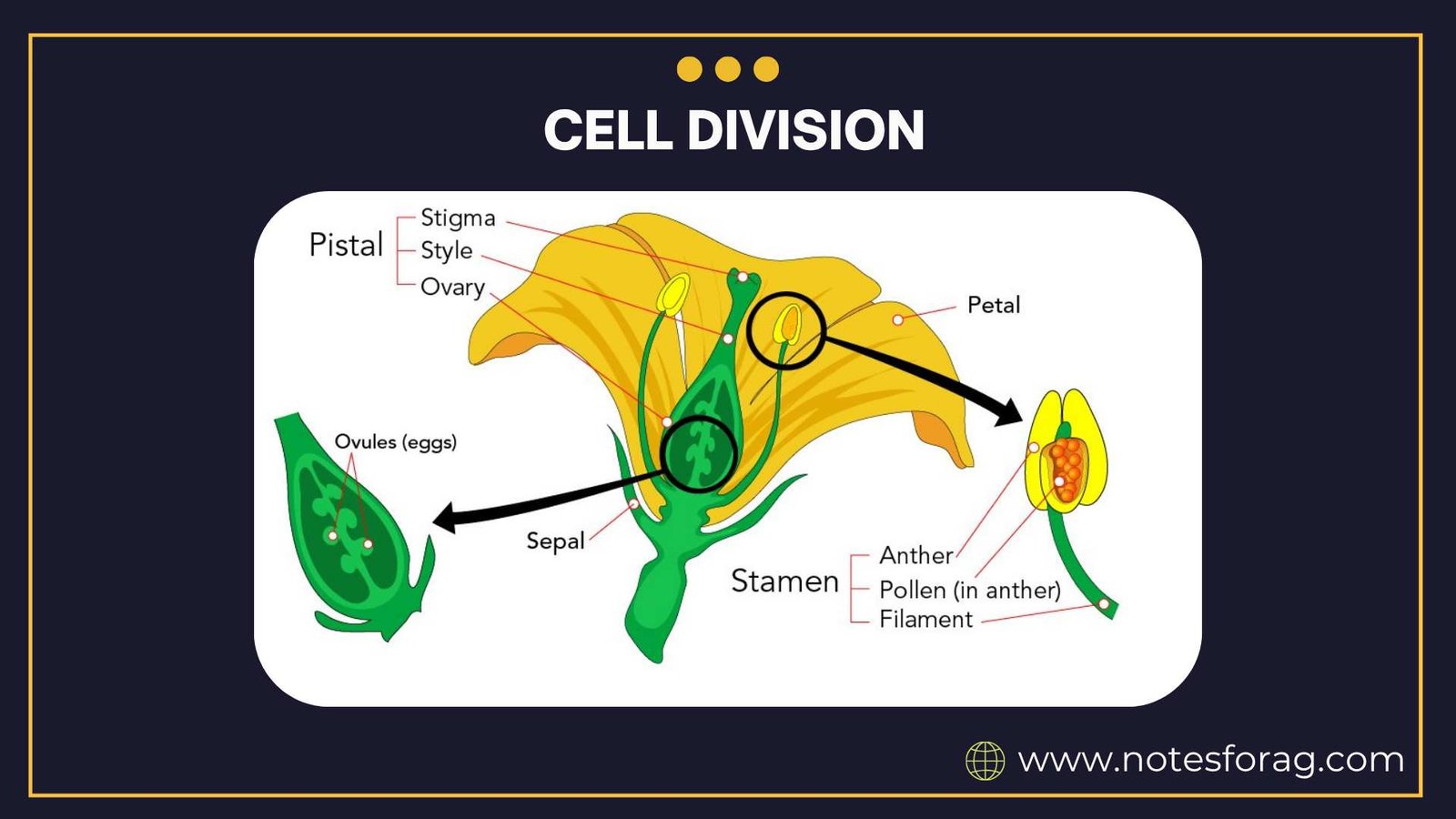INTRODUCTION
Cell division is a fundamental biological process through which cells reproduce and ensure the continuity of life. It involves the division of a parent cell into two or more daughter cells. This process is essential for growth, development, tissue repair, and reproduction in all living organisms. In multicellular organisms, cell division supports development from a single cell into a complex body, while in unicellular organisms, it serves as the primary mode of reproduction.
Cell division also maintains genetic information across generations, with strict control systems to ensure accuracy. The process is orchestrated by numerous proteins and signaling pathways that regulate the timing and fidelity of division. There are two main types of cell division: mitosis and meiosis. Both types are tightly regulated and involve several stages to ensure accurate distribution of genetic material and cellular components.
SUMMARY OF CELL DIVISION
- Cell division is the process by which cells reproduce, crucial for growth, development, repair, and reproduction in all living organisms.
- It occurs mainly in two forms: mitosis for producing identical cells and meiosis for generating genetically diverse gametes.
- Proper regulation of cell division ensures genetic stability, while errors can lead to diseases like cancer.
Table of Contents
DEFINITION
Cell division is the biological process by which a single parent cell divides into two or more daughter cells. It is a vital function in all living organisms, enabling growth, tissue maintenance, and reproduction. During cell division, the genetic material (DNA) is precisely duplicated and equally distributed between the daughter cells. In addition to duplicating chromosomes, cells also replicate organelles and reorganize the cytoskeleton to support the formation of new cellular boundaries.
TYPES OF CELL DIVISION
1. Mitosis

Mitosis is a type of cell division that results in two genetically identical daughter cells, each having the same number of chromosomes as the parent cell. It is crucial for growth, tissue repair, and asexual reproduction. Mitosis occurs in somatic (non-reproductive) cells and maintains chromosomal stability across cellular generations.
1.1 Phases of Mitosis
a. Interphase
Interphase is the preparatory phase during which the cell grows, duplicates its DNA, and prepares for mitosis. It includes three sub-phases: G1 (cell growth and biosynthesis), S (DNA replication), and G2 (final preparations and checkpoint activation). Interphase ensures that the cell is ready to enter the mitotic phase with a complete and undamaged genome.
b. Prophase
Chromatin condenses into visible chromosomes, and the nuclear envelope starts breaking down. The spindle apparatus begins to form from the centrioles. Centrosomes migrate to opposite poles, and microtubules extend toward the cell center, facilitating chromosome movement.
c. Metaphase
Chromosomes align at the metaphase plate (equator of the cell), and spindle fibers attach to their centromeres. This precise alignment ensures that each daughter cell receives one copy of each chromosome.
d. Anaphase
Sister chromatids are pulled apart by spindle fibers and move toward opposite poles of the cell. This movement is mediated by motor proteins and ensures the equal distribution of genetic material.
e. Telophase
Chromosomes reach the poles, decondense into chromatin, and are enclosed by a newly forming nuclear envelope. The spindle apparatus disassembles, and the cell prepares for the final separation.
f. Cytokinesis
Cytokinesis is the division of the cytoplasm, resulting in two separate daughter cells. In animal cells, a cleavage furrow forms, pinching the membrane inward. In plant cells, a cell plate develops to form a new cell wall.
2. Meiosis

Meiosis is a type of cell division that reduces the chromosome number by half, producing four genetically unique daughter cells. It occurs only in reproductive cells (gametes) and is essential for sexual reproduction. Meiosis introduces genetic diversity through recombination and independent assortment, which are crucial for evolution.
2.1 Stages of Meiosis
Meiosis involves two successive divisions: meiosis I and meiosis II.
a. Meiosis I
- Prophase I: Homologous chromosomes pair up and exchange segments (crossing over) through a structure called the synaptonemal complex. This enhances genetic diversity.
- Metaphase I: Paired chromosomes align at the cell’s equator. Each pair orients independently, leading to varied genetic combinations.
- Anaphase I: Homologous chromosomes separate to opposite poles while sister chromatids remain joined.
- Telophase I and Cytokinesis: Cells divide, resulting in two haploid cells with half the number of chromosomes.
b. Meiosis II
- Prophase II: Chromosomes condense, and spindles form in each haploid cell without DNA replication.
- Metaphase II: Chromosomes align at the equator as in mitosis.
- Anaphase II: Sister chromatids are separated and pulled to opposite poles.
- Telophase II and Cytokinesis: Four genetically distinct haploid daughter cells are formed, completing meiosis.
IMPORTANCE OF CELL DIVISION
1. Growth and Development
Cell division increases the number of cells, enabling the growth of organisms from a single fertilized egg into a complex multicellular structure. Proper regulation of mitotic division determines organ size, structure, and function.
2. Tissue Repair and Regeneration
Damaged or dead cells are replaced through mitosis, ensuring continuous tissue maintenance and healing. Stem cells play a crucial role in tissue regeneration, responding to injury and physiological needs.
3. Reproduction

- Asexual reproduction in unicellular organisms occurs through mitosis, allowing rapid population increase.
- Sexual reproduction requires meiosis to form gametes with half the genetic content, ensuring genetic recombination and variability.
4. Genetic Stability and Variation
Mitosis maintains genetic stability by producing identical cells for normal function. Meiosis promotes genetic diversity through crossing over and random assortment, key drivers of evolution and species adaptation.
DIFFERENCES BETWEEN MITOSIS AND MEIOSIS
| Feature | Mitosis | Meiosis |
|---|---|---|
| Number of Divisions | One | Two |
| Number of Daughter Cells | Two | Four |
| Genetic Identity | Identical to parent | Genetically different |
| Chromosome Number | Same as parent (diploid) | Half of parent (haploid) |
| Occurs In | Somatic cells | Germ cells |
| Function | Growth, repair, asexual reproduction | Sexual reproduction |
CONTROL OF CELL DIVISION
Cell division is controlled by regulatory proteins called cyclins and cyclin-dependent kinases (CDKs). These molecules ensure that cells divide only when conditions are appropriate. They regulate transitions between cell cycle phases and activate necessary proteins at each stage. Disruption in this control system can lead to uncontrolled cell growth, often resulting in cancer.
CELL CYCLE CHECKPOINTS
Cell cycle checkpoints are control mechanisms that ensure the fidelity of cell division. The three main checkpoints are:
1. G1 Checkpoint
Determines if the cell is ready to enter DNA synthesis (S phase). It evaluates cell size, energy levels, and DNA integrity.
2. G2 Checkpoint
Ensures all DNA is replicated and checks for damage before mitosis. If errors are found, the cell cycle halts for repair or triggers apoptosis.
3. M Checkpoint
Confirms that all chromosomes are properly aligned and attached to the spindle before proceeding to anaphase. This checkpoint prevents chromosome missegregation.
SIGNIFICANCE IN MEDICINE AND BIOTECHNOLOGY
Understanding cell division is crucial for cancer research, regenerative medicine, genetic engineering, and drug development. Controlled manipulation of cell division enables stem cell therapy and treatment of degenerative diseases. It also aids in understanding genetic disorders, congenital anomalies, and fertility treatments. Modern technologies like CRISPR and gene editing rely on the knowledge of cell cycle and division mechanisms.
CONCLUSION
Cell division is an essential life process that enables organisms to grow, reproduce, repair damage, and maintain genetic continuity. Mitosis ensures the maintenance and replacement of cells in the body, while meiosis is critical for sexual reproduction and genetic variation. Understanding the phases, control mechanisms, and types of cell division allows scientists and medical professionals to address challenges in health, agriculture, and biotechnology. A detailed grasp of these processes also forms the foundation for innovations in cancer therapy, regenerative treatments, and developmental biology.
Frequently Asked Questions (FAQs)
What is cell division in biology?
Cell division is the natural process by which a single cell splits into two or more new cells. This process helps living organisms grow bigger, replace old or damaged cells, and produce new cells for reproduction. It ensures that each new cell gets the right amount of genetic material and can function properly.
What are the main types of cell division?
There are two main types of cell division: mitosis and meiosis. Mitosis makes two new cells that are exactly like the original cell this happens in body parts like skin or muscles. Meiosis happens only in reproductive organs and creates four new cells (like sperm or egg cells), each with half the usual number of chromosomes. This helps pass on genetic traits and allows variation in offspring.
Why is cell division important for living organisms?
Cell division is very important because it helps living things grow, heal injuries by replacing damaged cells, and reproduce. Without cell division, no new cells would form, and the body wouldn’t be able to repair itself or continue to live. In humans and animals, it also helps form sperm and egg cells for reproduction.
Related Articles

